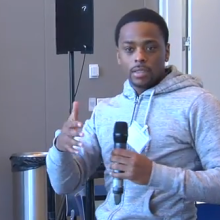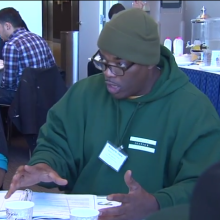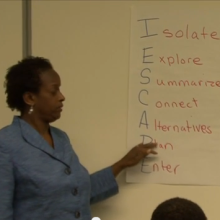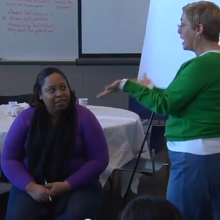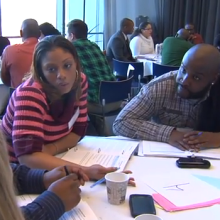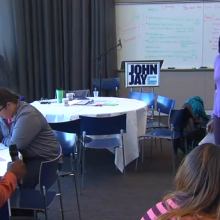In This Section:
The tools in this section were presented by the Youth Development Institute at a training for the NYC Justice Corps staff in January 2014. Every section below includes both videos and companion documents to download.
Factors that foster resiliency
Why do some young people get caught up in the justice system while others don’t? Protective factors that foster resiliency help all young people achieve positive outcomes—including young people who’ve been labeled “at-risk” or have come into contact with the justice system. The video Factors that Foster Resiliency introduces the positive supports that help young people overcome challenges and make their way to healthy adulthood. In the video, staff of the NYC Justice Corps talk about the supports that helped them transition through young adulthood. The companion document, Promoting Factors that Foster Resiliency, details the ways that programs can support young adults in building resiliency.
Strategies to promote resiliency
In a series of videos about promoting resiliency, NYC Justice Corps staff share their strategies for engaging justice system-involved young adults in making positive changes in their lives. Staff talk about how they build healthy rapport with young people in the video Caring Relationships with Staff. In the video Opportunities for Youth Contribution, staff highlight the leadership roles they’ve created for program graduates and the ways young adults participate in program decision-making. The video Promoting Resiliency in the NYC Justice Corps details the many program strategies that are working to nurture young adults—and the challenge to staff to do even better.
Managing conflict in a youth development context
In the video Managing Conflict: The Conflict Cycle, trainers from the Youth Development Institute provide a step-by-step breakdown of how conflict begins with a trigger, escalates to a crisis, and concludes in a recovery period. The video also highlights what staff can do at each point along the cycle to prevent and de-escalate crisis as well as cope with the aftermath.
Print materials accompany this video:
How can we manage conflict in a way that promotes youth development—that makes it possible for young people to stay in the program after a conflict rather than dropping out? The video Managing Conflict: Restoring Relationships focuses on a scenario drawn from real-life conflict between staff and participants in the NYC Justice Corps. Staff learn how to manage the conflict using the principles of prevention and de-escalation, as well as how to restore relationships between staff and young people after a conflict. A print version of the Managing Conflict Scenario is also available. After viewing the video and/or reading the conflict scenario, professionals working with young adults may also use the Four Stages of Conflict Worksheet to analyze this conflict or others they have experienced. Use this worksheet to identify potential strategies for managing conflicts.
Adolescent brain development can be a significant factor in how young people react to conflict. It’s important to remember that the frontal lobe, which controls impulses and aggression, and engages in longer-term perspective, continues to mature through the 20s. Adolescents think mostly with the back of the brain where emotional processing occurs. A review of the Youth Development Toolbox Intro, especially the tools Stages of Adolescent and Young Adult Development and Adolescent Brain Development, will enhance understanding of how to manage conflict with young adults.
Managing conflict with the I ESCAPE technique
When conflicts arise in the NYC Justice Corps, the staff are called upon to manage these situations in a way that promotes learning and new awareness for the young people in the program—and keeps the young people engaged in services. In the video Managing Conflict: I ESCAPE, Part 1, staff of the NYC Justice Corps perform role plays depicting conflict scenarios during community benefit projects and then use the I ESCAPE steps to debrief the scenarios. This tool is particularly useful for adults who manage conflict situations among young people who are doing community service. In the video Managing Conflict: I ESCAPE, Part 2, staff incorporate the I ESCAPE steps into role plays of various conflict situations that arise with young adults in the NYC Justice Corps.
More about I ESCAPE: This method of interacting with young people involved in conflicts is consistent with youth development principles and offers a way to restore relationships and help the young people stay engaged in the program during and after a conflict. The steps of I ESCAPE are summarized in the document Life Space Interviews: I ESCAPE (adapted from The Therapeutic Crisis Intervention Student Workbook, Martha J. Holden, MS, Sixth Edition, Residential Child Care Project, Cornell University, 2009). Use this interview guide document in conjunction with the I ESCAPE videos in this Toolbox.
It’s also important for staff to be aware of their own triggers, which may lead to or escalate conflicts with young adults. In the video Managing Conflict: Triggers for Staff the NYC Justice Corps staff members talk about some of the “hot button” issues that can lead them into conflict with young people in the program. In conjunction with this video, professionals working with young adults can use the Check Yourself Before You Wreck Yourself Worksheet to identify their own triggers and consider the impact of those triggers on their relationships with youth.


